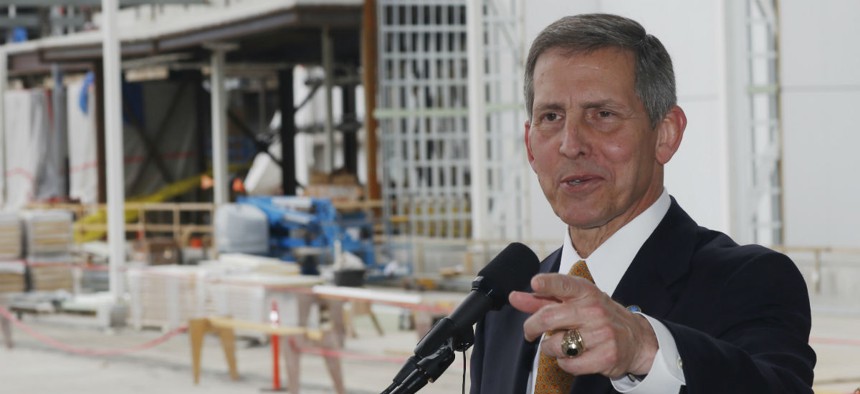
VA Deputy Secretary Sloan Gibson speaks at a press conference near construction of the VA hospital in Aurora, Colo. David Zalubowski/AP
Veterans Affairs Deputy Teams with Boss on Corporate-Style Reforms
Gibson promises “sea change” in managing for customer needs.
Two years ago, the Veterans Affairs Department’s top two executives were private citizens sipping wine together with their families in Sonoma, Calif., little imagining that soon they would team up to bring corporate-style budget and cultural reforms to “the largest health care organization in America.”
Sloan Gibson, the VA’s deputy secretary and chief operating officer, described a fresh team and a coming “sea change” in management to transform a department in crisis into “a world-class customer service organization,” speaking at a Thursday luncheon with members of the Professional Services Council.
Secretary Bob McDonald “and I have been both business partners and friends for 40 years,” Gibson told the contractors. “We were West Point classmates, with rooms next door to each other and eating three meals a day together, [later] vacationing together with our spouses.”
After 16 months grappling with scandals over fraudulent reports on patient wait times and construction cost overruns, Gibson said he is inspired to use the crisis not just to make changes faster, but to “do things now that the VA otherwise could never have done.”
Gibson contrasted his 350,000-employee department and its $169 billion budget with a Fortune 500 company, saying, the VA “has 535 board members, meaning Congress, [and] a workforce 62 percent unionized, where hiring is hard, firing is harder. There’s an onerous acquisition process, and an entrenched renowned bureaucracy that is visible like an open book, subject to scrutiny by outside interests,” he said. “It is not a system that is integrated,” Gibson added. “If there is another organization facing a tougher challenge, I like to know what it is and peek under its tent.”
Gibson asked the industry representatives to imagine “running the largest health care system with a financial management system that is 20 years old.”
On the positive side, VA has several new executives, Gibson said, mentioning the swearing in this week of Undersecretary for Health Dr. David Shulkin and Chief Information Officer LaVerne Horton Council. Chief Veterans Experience Officer Tom Allin came aboard in January, Gibson said, adding praise for procurement reforms being pursued by Gregory Giddens, principal executive director of the Office of Acquisition, Logistics and Construction.
Gibson reeled off a litany of the VA’s large-scale programs in its nine lines of business, 150 hospitals, 24,000 doctors, 91,000 nurses and 1,800 academic affiliations in which medical researchers also treat patients at VA medical centers. The department gives 2.2 million veterans loan guarantees and has the lowest foreclosure rate in the industry, and runs the 10th largest health insurance provider, he noted. “If the VA were in the private sector, it would be in the Fortune 10,” he said.
Despite its troubles, the VA can boast a $1.8 billion annually funded medical research program that is credited over the years with three Nobel prizes and such breakthroughs as electronic health records, bar code patient bracelets, the nicotine patch, use of aspirin to prevent heart attack, a licensed vaccine for shingles, and mind control to activate robotic arms, Gibson said.
“But we still have much room to improve in access,” Gibson acknowledged. Though nearly all veterans express satisfaction with VA hospitals and rehab centers, “the more care we provide vets, the more veterans come for care.” Nationally, wait times for the VA’s 30-day appointments in the past year have come down to an average of four days for primary care, Gibson said, thanks to a 2.8 percent budget hike, 12,000 new staff, 1.2 million new square feet of space and offering of services on evenings, weekends and online.
But at well-publicized sites such as the medical centers in Phoenix and Las Vegas, usage went up more than predicted, he said—the VA has had to accommodate 7 million new appointments nationwide. Many are attracted by financial incentives such as free knee replacements and hearing aids for which Tricare and Medicare would charge co-payments.
The improvements in customer service are being achieved in part through budget flexibility, Gibson said, noting that Congress has agreed that hepatitis-C does not respect budget cycles. “We have to build a requirements-based budget, which is a sea change for an organization that historically has managed to a budget number” rather than calculating resources based on the needs of veterans and, for example, the anticipated backlog of medical claim appeals hearings.
Management reforms are being built around five pillars, Gibson said: the needs to improve the veterans’ experience; improve the employee experience; improve internal support services including acquisition and logistics; establish a culture of continuous improvement, as in the Six Sigma program; and enhance strategic partnerships both public and private. “This will change the way we operate with the business community,” he said, promising a “compete remake” of the acquisition process. Gibson called himself a “champion of the supply chain” aiming at a system that allows execution that “that will be more like Amazon.”
Gibson spoke proudly of his personal business relationships with heads of three major construction firms doing business with VA, even though his staff had warned him to steer clear for fear of favoritism and litigation.
He told the contractors, “We need to invest in a state-of-the art logistics management system to be better customers than we are today. We need a lot of help, and it takes humility to admit we don’t know everything.”







